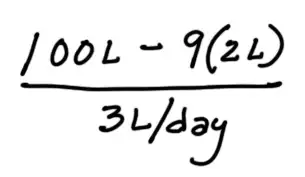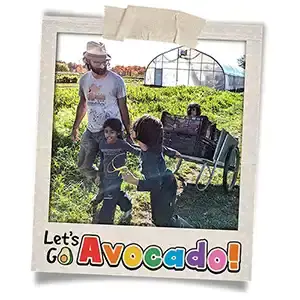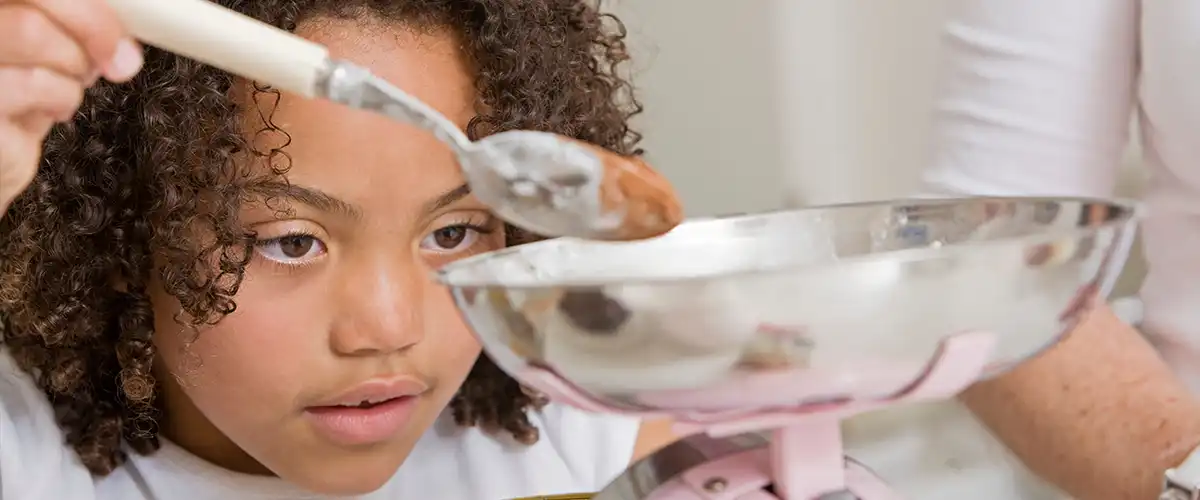When I think about teaching kids math, I don’t picture the rigid arithmetic often taught in schools. Instead, I see it as an opportunity to develop something deeper: mathematical intuition. For me, math is all about understanding relationships and patterns. It’s less about teaching the tools of arithmetic and more about showing them how to experience the world through numbers.
In this article, I want to share some practical ways to integrate math into daily life, making it a natural and enjoyable part of our routines. The goal here is to help our kids build a positive relationship with math and numbers, one fun activity at a time.
Table of Contents
Integrating Math into Daily Life: Practical Tips for Homeschooling Parents
Getting Comfortable With Numbers
Kids are exposed to math everywhere, from measuring ingredients for a recipe to dividing up candies at halloween. Math is about making sense of the relationships between things. Developing this intuition is crucial, and it goes beyond just getting the right answer to a mathematical problem. It’s about creating a space where numbers aren’t scary or intimidating, but are a fun and natural part of life. From there, they can grow to have real meaning.
It is absolutely important for kids to learn and understand math, but I don’t believe that this should be pursued as the principal goal.
Now I want to emphasize here that it is absolutely important for kids to learn and understand math, memorize their multiplication tables, learn how long division works, know the tricks on how to multiply fractions, and so on. These things are all incredibly important. But I don’t believe that these things should be pursued as goals in and of themselves. For example, teaching a child to read is important, but we do it through stories – kids are motivated to read in order to access the incredible imaginative worlds hidden away behind this wall of letters and words. The motivation to read comes from the experiences unlocked by reading, not simply the satisfaction of being able to read a word. In the same way, the motivation to learn math will come from the hidden secrets that will be exposed through that knowledge.
The motivation to learn math will come from the hidden secrets that will be discovered through that knowledge.
The Meaning Behind Numbers
Let me tell you a story about one of my deep and meaningful relationships with a number. When I lived in India as a child for a short while, our morning routine involved pumping water into a barrel and using a jug to bathe. The jug was a 2 liter jug, and I used 9 jugs of water to take a bath. So that’s a total of 18 liters. It was a lot of effort to get that water, and I tried to use as little as possible because of the effort involved. I wasn’t thinking about conserving water – I just knew what each jug cost me in terms of effort. That effort is ingrained in my mind. So is the number 9. I have an intimate knowledge of what the number 9 feels like. It has a distinct feeling of tired muscles, and smells of jasmine soap, kerosene lanterns (there was no power), and the smell of fresh bread from the oven just a few feet away. The number 9 also sounds like the morning rooster, and the clucking of the hens from next door, and the sound of the morning prayer from the mosque nearby. The number 9 feels like the hard and rough black slate stones of the kitchen floor, a corner of which was where the bath area was located. It also feels like the initial fear of pouring cold water over myself, followed warmth that develops in the fingertips as the water runs down, and the splashing sound it makes when it hit the floor.
Today, my number 9 has more meaning. The average amount of water a person uses in the shower is about 100 liters! That’s over 5 times more water than I used to use (9 jugs = 18 liters), and it comes effortlessly through a pipe from somewhere. Imagine the amount of water we could save if more people became acquainted with my number 9. Imagine the difference 82 extra liters of fresh drinking water per shower would make if exported to countries experiencing drought, where water is rationed and people and children go thirsty.

This is the number of days of drinking water we waste every time we use a shower vs bathing with jugs of water.
Now of course it isn’t that simple, but the point is that math is about relationships. I don’t expect our children to relate to my relationship with my number 9, or the relationship my number 9 has with the world’s water shortage. But what I do know is that these kinds of relationship-building moments with numbers and math occur every day, for everyone. You have the opportunity, as an educator, as a parent, to seize on these moments to encourage the growth of a friendly, and maybe even lifelong and profound relationship with numbers and math. Math and numbers provide a unique window to view the world from a different perspective. Emphasizing this over arithmetic is a key strategy I use to teach my kids math. The above formula is actually pretty basic arithmetic. But the formula means something, and it holds a secret, just like a story holds a secret for those who cannot read. It’s a secret code. Kids love solving those, and in this case, they key is math. The key is basic arithmetic. Now comes your opportunity to teach what learning math can reveal about the world around us.
Discover your fascination with math from your own perspective, your own interests, your own experiences. By adopting this attitude, we teach our kids to be equally delighted and amazed by what they learn.
I tell my kids to get comfortable with the language of numbers. It’s everywhere. Math is part of our existence. It’s doesn’t go away when we close our eyes, any more than the world goes away. Might as well get comfortable, and get to know it. Make friends with it. Discover your fascination with it from your own perspective, your own interests, your own experiences.
A lot of the fear kids have of math comes from them observing our own relationship with it, and how we interact with it. By adopting an attitude of wonder and fascination when looking at the world through ‘mathematical’ glasses, we teach our kids to be equally delighted and amazed by what they see.
Practical Ways to Integrate Numbers Into Daily Life
Cooking and Baking
- Measure ingredients together, discussing fractions and quantities.
- Adjust recipes, introducing concepts of multiplication and division. For example, a recipe produces 2 servings. How can we update the recipe so that it can provide 4 servings?
Grocery Shopping
- Compare prices and weigh produce to introduce concepts of budgeting and estimation.
- Use a calculator to add up costs or calculate discounts, showing practical applications of arithmetic. There’s nothing wrong with using a calculator – they can actually be incredibly useful to show the real-world utility of math. If a child is able to figure out that division is needed in order to get the answer to the question “If apples cost $3.99 a kilogram, how much does 600 grams of apples cost?“, then whip out that calculator, show them how to use it, and give them the satisfaction of an answer. The fact that they know division is needed is a major milestone.
Gardening
- Measure spaces between plants, count seeds, and track growth to teach measurement and counting. I personally love using gardening as a “sandbox” for experimenting with math. There are just so many real-world applications of mathematics in gardening.
- One of the ultimate gardening math problems is actually simple to ask, but requires a lot of thought to go through. For older kids, you could ask: “For a family of 5, if we wanted to be vegetarians and self-sustaining, which crops should be plan, when, and how many?“. It’s a simple question to ask, but figuring it out is like a puzzle that parents and kids can work on over days and weeks. It requires research, evaluation of personal family life, plant lifecycles and harvesting knowledge, knowledge of plant yields, pollination, etc etc. So much mathematical richness in that one question. If you wanted to give this a try, I would suggest to start with a single plant – ie, “If we wanted to never buy tomatoes again, what would our planting quantity and schedule look like?“.
Board Games and Puzzles
- Choose games that involve counting, strategy, and resource management. Games like Settlers of Catan, UNO, Battleship, Chess, Go, etc – they’re all fun ways to introduce math, from numbers and arithmetic to patterns and mathematical relationships, into family time. Remember that the goal here is to introduce math as a regular part of life, as opposed to a math class at a specific time. A specific math class should be very short and to the point – ie, learning how to use long division as a tool. Spend no more than 10 minutes a day on a math ‘class’. The tool’s not the critical thing here. Do you even know long division yourself?
- Discuss probability and chance in games involving dice or cards.
Travel and Navigation
- Calculate travel times and distances, introducing concepts of speed, time, and estimation. This can be a fun activity when planning a trip or vacation. Replace the tiresome “Are we there yet?” with a fun game to help them figure it out themselves.
- Use maps to discuss scale and geography. Proportion and scale are really interesting ways to bring math into topics like geography, art, construction projects, model making, lego building, etc. Cultivating their ability to estimate proportion and scale will be critical to their success in math. It will help them to gain an intuitive instinct for whether or not their calculations are correct when working on more complex problems in the future.
Everyday Problem-Solving
- Involve kids in budgeting for family activities or saving for a desired item.
- Measure objects around the house, compare lengths, weights, or volumes. Measuring and learning about units of measure in both metric and imperial is a fun and effective way to engage various aspects of math, proportion, and scale. One fun activity kids always enjoy is rearranging their room. Have them make a plan of their room on paper, and measure out their bed, dresser, desk, etc. Then have them come up with a new layout on paper, taking into account the size of the room and how their large items will fit. Then help them to rearrange their room. For kids, it engages their creativity, their sense of personal taste and style, the rewards of a new and clean space, and the fun they had in planning it, where measuring and math were critical. I personally believe that every child should have a small measuring tape in their pencil case.
Key Takeaways
Integrating math into daily life helps children develop a positive relationship with numbers. Here are the key takeaways:
Embrace Mathematical Intuition:
- Focus your efforts on their understanding of relationships and patterns as opposed to a singular focus on arithmetic.
- Encourage seeing math as part of the world around us. Look for and point out the various ways math and numbers exist in the world.
Create a Positive Space for Math and Numbers:
- Show that numbers are fun and not intimidating, by integrating math into fun daily activities.
Practical Daily Activities:
- Cooking and Baking: Measure ingredients and adjust recipes.
- Grocery Shopping: Compare prices and use calculators for budgeting.
- Gardening: Measure plant spacing and count seeds.
- Board Games: Choose games involving counting and strategy.
- Travel: Calculate travel times and use maps for geography.
- Problem-Solving: Involve kids in measuring and planning, room organization, time management, and other kids of daily activities that require planning based on numbers.
Develop a Relationship with Numbers:
- Consistently integrate math into daily routines.
- Encourage curiosity and celebrate achievements.
By making math a natural part of life, we can help children build a strong, positive relationship with numbers.

There’s a lot to explore right where we are, in our own neighborhoods and backyards! Join us while we get off the couch and explore the everyday wonders of nature, science, space, engineering, art, and anything else we stumble upon during on our adventures.



